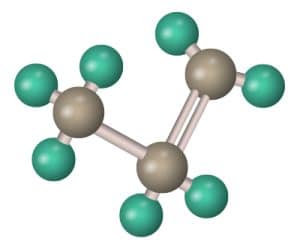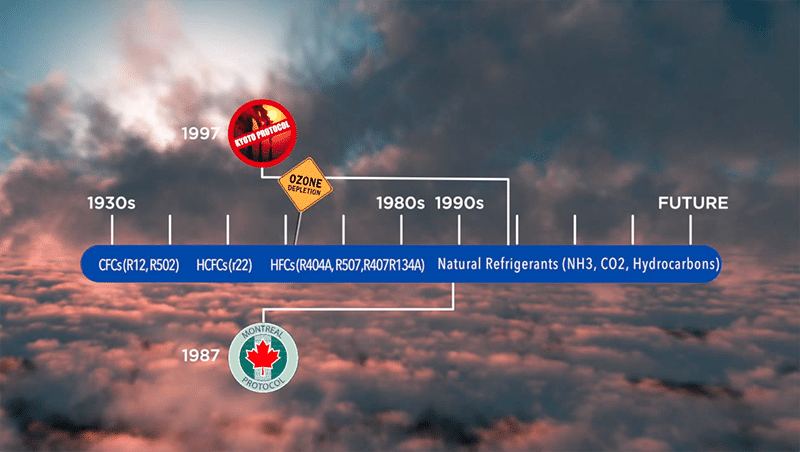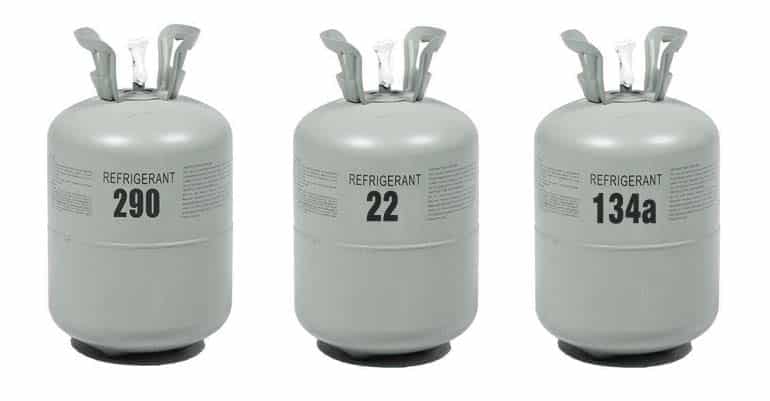When most people think of propane, the commonly used fuel for domestic and commercial heating applications as well as for low emissions transportation uses (such as for buses and other fleet vehicles) comes to mind.
Used as a refrigerant (R-290), propane has no ODP and low GWP. With increasing regulation of refrigerants, HCs along with other natural refrigerants have been getting more and more attention. For food retailers and others seeking alternatives to highly regulated HFCs and other synthetic refrigerants, low-GWP natural options are becoming decidedly more attractive. Foremost among these, CO2 an A1 refrigerant and ammonia (NH3) a B2L refrigerant has seen the widest spread acceptance domestically. NH3 has long been used in manufacturing and industrial cooling applications where there is little to no risk of exposure to the public. CO2 is more frequently becoming the choice of forward-looking users who aim to implement sustainable options that avoid the regulatory burdens increasingly imposed on HFC use. But CO2 and NH3 are not without certain challenges to even wider use.
CO2 for instance requires higher operating pressures than other refrigerants and special equipment to be effective in warmer climates due to its higher condensing point. Recent advances in technology have helped to mitigate concerns like these but some potential adopters may still be weary of CO2.
Although ammonia is also generally considered to be benign to the environment, it likewise entails its own set of concerns; chief among them is its toxicity. This is the main reason (alluded to above) that limits its use to primarily industrial and manufacturing applications where the risk of exposure to the public is negligible.
The Propane Alternative
 Propane as a refrigerant offers users an alternative that avoids these obstacles while at the same time providing a number of benefits. Unlike ammonia, for instance, it entails no materials problems since it is compatible with copper and also is usable with semi-hermetic and hermetic compressors. Its compatibility with the latter is key to enabling its use in fully sealed systems. Such an approach all but eliminates risks due to main factor that has until recently limited adoption, its flammability.
Propane as a refrigerant offers users an alternative that avoids these obstacles while at the same time providing a number of benefits. Unlike ammonia, for instance, it entails no materials problems since it is compatible with copper and also is usable with semi-hermetic and hermetic compressors. Its compatibility with the latter is key to enabling its use in fully sealed systems. Such an approach all but eliminates risks due to main factor that has until recently limited adoption, its flammability.
Propane is eco-friendly, highly efficient and high performing. The EPA in 2011 approved propane in small quantities for use in standalone retail refrigerators and freezers. Its use could effectively eliminate EPA compliance concerns food retailers and others face with refrigerants for the foreseeable future.
R-290 GWP = 3
Compared to systems using R-22 and R-134a, a 40 percent lower refrigerant charge is needed for the same size R-290 system. Those refrigerants have GWPs of 1,810 and 1,430 respectively, compared to just a GWP of 3 for R-290. R-404A, to take a currently used HFC, has a GWP of nearly four thousand. Hydrocarbons in general operate at lower discharge temperatures, which improves system reliability. Propane’s relatively low mass flow (approximately 55 to 60 percent compared to R-22) further provides for the possibility of a greatly reduced refrigerant charge. It does, however, operate at similar pressure levels and refrigeration capacity to R-22. R-290 systems, consequently, can be designed to meet similar criteria but with smaller footprints and higher efficiencies.
Industrial refrigeration operators have long recognized these and other benefits. Plants worldwide have used R-290 in large-scale operations for many years to the point where a study from Bitzer (a compressor manufacturer cited in ACHR News) stated, “it is a proven refrigerant.”
Along with industrial refrigeration applications, propane refrigeration is also used on a smaller scale. “R-290 can
be used in smaller, compact systems with low refrigerant charges, like residential A/C units and heat pumps,” the report states. “Furthermore, a rising trend can be seen in its use with commercial refrigeration systems and chillers.”
Consideration when sizing components can be given to the relatively low mass flow (approximately 55 to 60 percent compared to R-22) it requires thus allowing for less of a refrigerant charge relative to R-22 in similarly sized systems.
Following EPA approval, 2013 saw the first domestic storewide use of R-22 with a majority of the display cases and walk-ins utilizing self-contained propane units. While this type of whole store adoption of R-22 use has since then be limited, the continued use and development of stand-alone display case applications has proceeded.
One manufacturer for instance, has released a self-contained island-style display case that achieves a 20-50 percent reduction in energy use compared to cases using HFC refrigerants; another benefit of propane’s greater efficiency.
While charge restrictions have limited propane use in the U.S. food retail industry to the stand-alone single condensing unit display cases, it’s been a different story in Europe. A Norwegian convenience store (c-store) chain for instance, has begun using similar types of cases (commonly referred to as cabinets in Europe) but instead of operating them as stand-alone units, ties them together in a micro-distributed system.
One U.S. manufacturer is testing the waters with a similar approach that uses a closed water loop to remove rejected heat from the cases. This allows the use of R-290 to be extended from island cases to multi-deck and door cases. The units are charged with just 150 grams, or 5.3 liquid ounces per circuit reducing the total amount of refrigerant needed for a full-store application by 95 percent or more.
Sample of an R290 self-contained island case.
Propane Drawbacks
Like any other refrigerant, R-290 is not without its concerns. Drawbacks that have mostly stood in the way of its use have to do with its flammability requiring that any use in systems be in accordance with flameproof regulations. In light of this concern, propane systems in the U.S. cannot have a charge greater than one hundred and fifty grams.
At least as recently as 2015, besides flammability and globally mandared low charge limits of 150g that restrict its use, other concerns were voiced regarding difficulties in getting it approved in light of fire and building codes. Likewise, special handling requirements and certifications were seen as potential hurdles. Even now, five years later a lack of trained and certified field technicians remains another stumbling block for many users.
But the basic issue of flammability means the demands for the safety technology required for its use include special devices to protect against excess pressures and special arrangements for the electrical system. It also means that innovative approaches to extending its use beyond stand-alone display cases as in the Norwegian and domestic chilled-loop examples, must be further developed.
On the plus side, propane’s use in plants requires practically no special features in the medium- to low-temperature ranges. It is therefore conceivable that at least on the industrial side, propane’s use domestically could considerably expand as more potential users become aware of its benefits.
Much wider usage in the retail food category seems at this point dependent on further advances in loop system technologies. In the meantime, however, increasing numbers of users are becoming sold on the merits of stand-alone applications for individual display cases. These units are typically equipped with casters that allow their use around the store since otherwise the only requirement there is, is to have an outlet in which to plug them into. As of 2017, discussions were underway among U.S. regulators to increase the charge limit for R-290 applications from the current 150g to 300g. Doing so, would likely propel propane’s use considerably forward.


